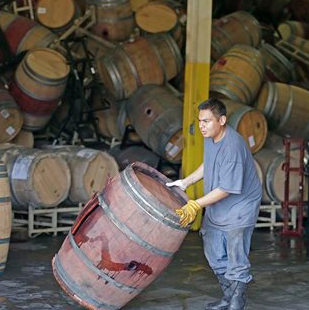NAPA, Calif. (AP) — The earthquake that jarred California’s wine capital caused $1 billion in damage, Napa County officials estimated Monday as business owners mopped up high-end vintages that spilled from barrels and bottles and swept away broken glass in the rush to get the tourist hotspot back in shape for the summer’s final holiday weekend.
With the dust still settling from Sunday’s magnitude-6.0 temblor centered near the city of Napa, government and tourism officials assessing its economic and structural impact encouraged visitors to keep flocking to the charming towns, tasting rooms, restaurants and spas that drive the Napa Valley economy.
While cleanup will take time and broken water mains remained a problem, they said, the worst damage and disruption was confined to the city’s downtown, where a post office, library and a 141-room hotel were among 150 homes and buildings deemed unsafe to occupy.
The strongest earthquake to hit the San Francisco Bay Area in a quarter-century also caused several injuries, triggered fires that destroyed or damaged six mobile homes, and ruptured gas lines.
“Clearly, we are concerned that people are going to see that it was a catastrophe, and it certainly wasn’t good, but it wasn’t a catastrophe by any means,” Clay Gregory, president of tourism organization Visit Napa Valley, said as workers at a shuttered downtown visitor’s center updated lists of open wineries and surveyed hotels about cancellations. “The real story is that it has impacted a very small part of the valley.”
In Napa Valley, two hotels and 12 wineries were still closed Monday, as well as many of the businesses downtown, he said.
Local officials have an early working estimate that Napa Valley suffered $1 billion in property damage, but they hope the long-term economic impact of the quake to businesses will be modest, Napa County Supervisor Bill Dodd said. He said 80 percent of the valley’s 500 or so wineries were unaffected.
If people “think Napa is devastated, it’s anything but devastated. We’re only 24 hours out from an earthquake, and we’re on our way back,” Dodd said.
CoreLogic Eqecat, which models economic losses from disasters, estimates that insured losses from the earthquake could range from $500 million to $1 billion. Vineyards have already started to harvest their grapes, crush them and store the juice. If the earthquake had happened before the harvest, Eqecat notes, the losses would have been lower.
The wine business and associated tourist crowds represent a bulk of Napa County’s economy. Visit Napa Valley estimates that 3 million tourists spend $1.4 billion a year within the county. The Napa Valley Vintners trade association says the industry generates more than $13 billion of economic activity each year, including 46,000 local jobs.
The Napa Valley Wine Train, which offers tourists a three-hour journey through 18 miles of wine country, canceled its service Monday but planned to resume trips Tuesday. Other tour operators said they were taking it one day at a time, readjusting tours as each winery decides when to reopen.
“We’ve definitely had to make some last-minute adjustments for this week as people are assessing damage,” said Sherry Laseke, whose family owns Saint Helena Wine Tours, a boutique luxury tour operator. “Everybody is dealing with broken glass.”
The 19th-century stone-and-masonry Victorian buildings that form the core of Napa’s downtown, and are part of the town’s attraction to tourists, were hit the hardest by Sunday’s earthquake. That included the Andaz Hotel, which suffered water damage and was declared uninhabitable on Sunday because of falling roof debris.
Front desk host Omar Hurtado stood outside with a push broom Monday, holding the door for the newly hired cleanup crews that had replaced the guests evacuated after the earthquake. The hotel is hoping city inspectors will clear it to reopen by the end of the week, he said.
“This is the time of year when we are sold out every night practically,” Hurtado said, noting that the August, September and October grape harvest represents the busiest time of year for both vintners and the visitors who come from all over the world to see them work.
Even with the earthquake making headlines and the hotel closed, people have been calling all day for reservations, he said.
“It looks like everybody is OK with what happened. They’ll come back,” Hurtado said.
Cynthia Kroll, an economist with the Association of Bay Area Governments who studied the economic impact of the Bay Area’s last big earthquake 25 years ago, agreed. Napa might have some immediate harm, but “I certainly don’t expect it to have any long-term effects on the area.”
Jake Gukowsky, 35, and his wife, Sarah, moved to San Francisco from New York last week and celebrated with a quick weekend trip to wine country. They browsed the Carneros inn winery Monday after having ruled out cutting short their vacation.
“In New York, they say it takes seven years to experience everything,” Jake Gukowsky said. “In California, it’s three days — wineries, an earthquake, and you’re in.”
A hotel closer to the epicenter, Holiday Inn Express near American Canyon, reported 10 cancellations and 500 telephone calls about quake damage, but remained 90 percent booked, said Gregory, of the tourism organization.
With the harvest just starting this week, he said, both the grape crush and the attendant peak tourist season should still be good, he said.
“The grapes don’t know there’s been an earthquake,” Gregory said.



